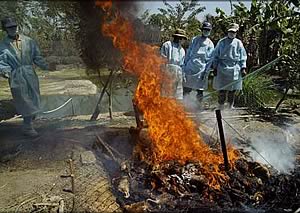 |
|||||||||
|
|||||||||||||||||||
Bird
flu outbreaks continue in Africa, Asia, Europe and Near East Despite the fact that the deadly H5N1 avian influenza virus, or bird flu, has now been confirmed in 45 countries on three continents, threatening human lives as well as livelihoods and depressing poultry prices in many regions, efforts to combat the disease on poultry farms are slowly proving successful on many fronts.
To date, the virus has killed 108 people, all in Asia. More than 200 million birds have died from the virus or through culling in efforts to slow the spread of the disease, but vigorous response to outbreaks in this region, particularly in Thailand, Viet Nam and China, appears to have reduced the transmission of the disease from poultry to humans, according to Joseph Domenech, Chief Veterinary Officer, FAO. Vaccination campaigns, such as the one carried out in Viet Nam, have also played an important role in helping some countries contain the spread of the disease, and recognizing the need for owner compensation schemes has not only helped alleviate economic hardship, it has also encouraged timely reporting of new avian influenza outbreaks. FAO in close collaboration with the World Organisation for Animal Health (OIE) continues to urge governments to concentrate containment efforts on the farm and emphasizes the role of human activity – trade and markets – which are the main spreaders of the virus but also are the areas that can be inspected, controlled and improved. Where wild birds may introduce the virus, the Rome-based organization says little can be done to control their movement but that action should be taken to reduce the risk and prevent their contact with domestic birds. “The need to keep domestic birds away from wild birds has been widely recognized and efforts to do so have been implemented in many countries,” said Domenech. FAO and OIE are working to strengthen veterinary services in developing countries to fight bird flu and face a large number of transboundary animal diseases that threaten the livelihoods of people and even national economies. In January this year, almost US$1.9 billion was pledged at a donor’s conference in Beijing to support country, regional and global programmes to combat bird flu. The conference produced a consensus that funding would be balanced between animal and human health activities. To fight the disease in the current situation, FAO said it needs US$36 million over the next three years for global and regional coordination. FAO also gives direct assistance to infected countries, countries at risk and newly infected countries and this requires additional support, which depends on the evolution of the situation and the scale of the national proqrammes FAO is asked to implement. FAO has so far received US$40 million and has signed agreements with donors for an additional US$20 million, which is expected to arrive soon.
|
|||||||||||||||||||

|
|
||||||||||||||||||
| home | agri-services | pedigree
pen | news | dairy | beef | machinery property | organisations | site map |
|||||||||||||||||||

